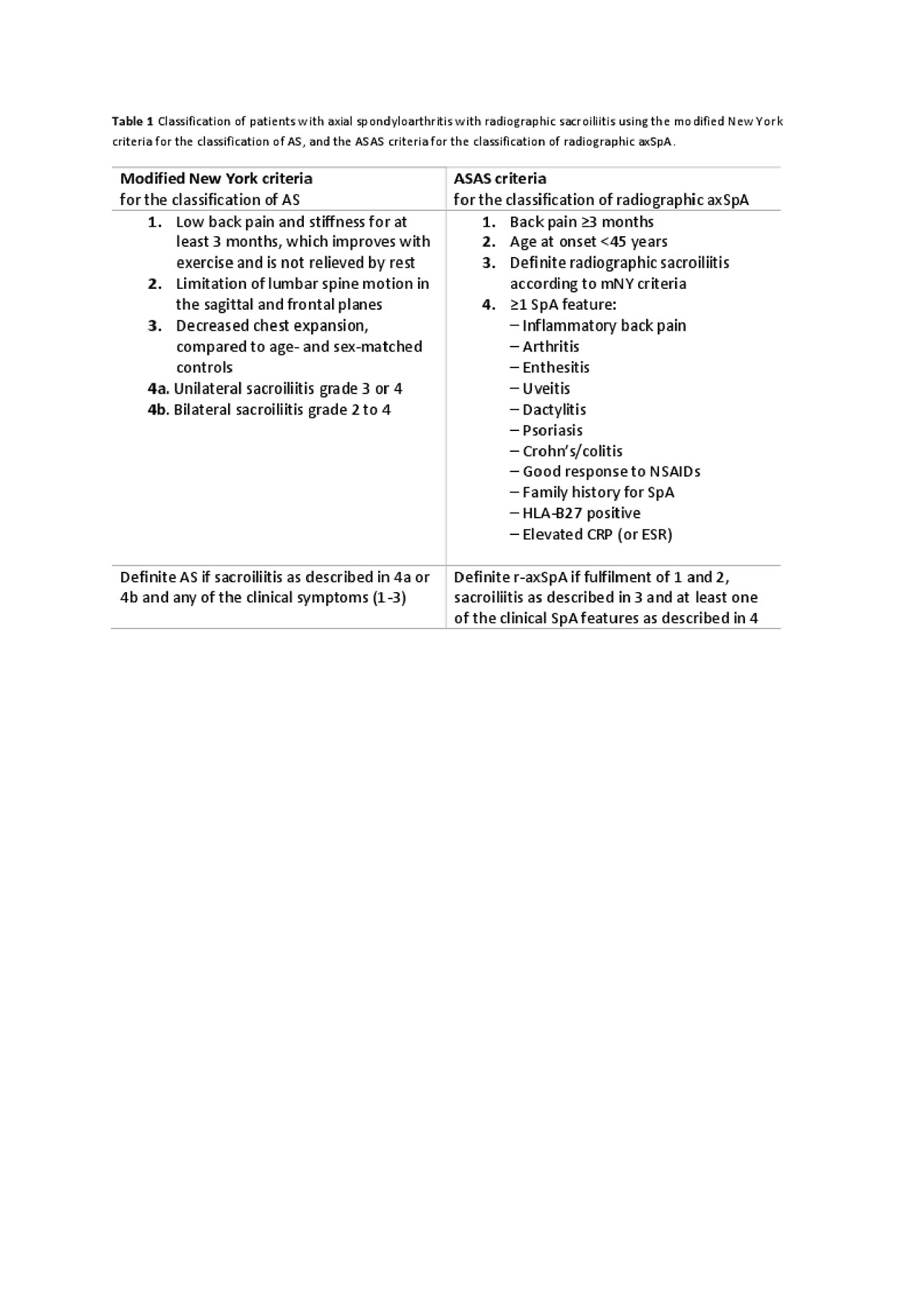Session Information
Session Type: Poster Session (Sunday)
Session Time: 9:00AM-11:00AM
Background/Purpose: Patients with axial spondyloarthritis (axSpA) with radiographic sacroiliitis may be classified using the modified New York (mNY) criteria as ankylosing spondylitis and using the more recent ASAS criteria as radiographic axSpA (r-axSpA).
In both the mNY and the ASAS r‑axSpA classification sets the radiographic criterion is the same but the additionally required features differ (Table 1). The aim of this study was therefore, to investigate if patients who fulfil the mNY criteria also fulfil the ASAS criteria for r‑axSpA and vice‑versa.
Methods: Patients diagnosed with axSpA who had back pain > 3 months and definite radiographic sacroiliitis according to the mNY radiographic criterion (#4a or 4b in Table 1), were selected from eight cohorts (ASAS, Esperanza, GESPIC, OASIS, Reuma.pt, SCQM, SPACE, and UCSF axSpA cohort). Subsequently we calculated the percentage of patients who fulfil the ASAS r‑axSpA criteria within the group of patients fulfilling the mNY criteria. In six cohorts (all except Esperanza and OASIS) we were also able to calculate the percentage of patients fulfilling the mNY criteria within the group fulfilling the ASAS r-axSpA criteria.
Results: Of the 3,882 patients fulfilling the mNY criteria, 93% also fulfilled the ASAS r‑axSpA criteria (Figure 1a). Inversely, of the 3,434 patients fulfilling the ASAS r‑axSpA criteria, 96% also fulfilled the mNY criteria (Figure 1b). In total, 89% (3607/4041) of patients fulfilled both criteria sets; 7% only the mNY criteria; 3% only the ASAS criteria and 1% neither set.
The main difference between the two criteria sets was caused by reported age at onset of back pain. Out of 275 mNY+ patients not fulfilling the ASAS criteria, 265 (96%) cases were due to the age criterion and 10 (4%) due to the absence of SpA features. The 134 mNY-/ASAS+ patients did not have mobility restriction or IBP but at least one other SpA feature instead.
Conclusion: Agreement between the mNY and ASAS r‑axSpA criteria is very high, with mostly the same patients being classified according to both criteria, which supports the interchangeable use of the terms AS and r‑axSpA. This has important implications for the axSpA research field, since acknowledging that both criteria sets identify the same patients implies that older literature on AS and newer literature on r‑axSpA can be directly compared.

Table 1 Classification criteria

Figure 1 Percentage of patients fulfilling ASAS r axSpA within subgroup fulfilling mNY criteria and vice-versa
To cite this abstract in AMA style:
Boel A, Moltó A, van der Heijde D, Ciurea A, Dougados M, Gensler L, Santos M, de Miguel E, Poddubnyy D, Rudwaleit M, van Tubergen A, van Gaalen F, Ramiro S. Are the Modified New York and ASAS Criteria Interchangeable in the Classification of Patients with Spondyloarthritis with Radiographic Sacroiliitis? [abstract]. Arthritis Rheumatol. 2019; 71 (suppl 10). https://acrabstracts.org/abstract/are-the-modified-new-york-and-asas-criteria-interchangeable-in-the-classification-of-patients-with-spondyloarthritis-with-radiographic-sacroiliitis/. Accessed .« Back to 2019 ACR/ARP Annual Meeting
ACR Meeting Abstracts - https://acrabstracts.org/abstract/are-the-modified-new-york-and-asas-criteria-interchangeable-in-the-classification-of-patients-with-spondyloarthritis-with-radiographic-sacroiliitis/
